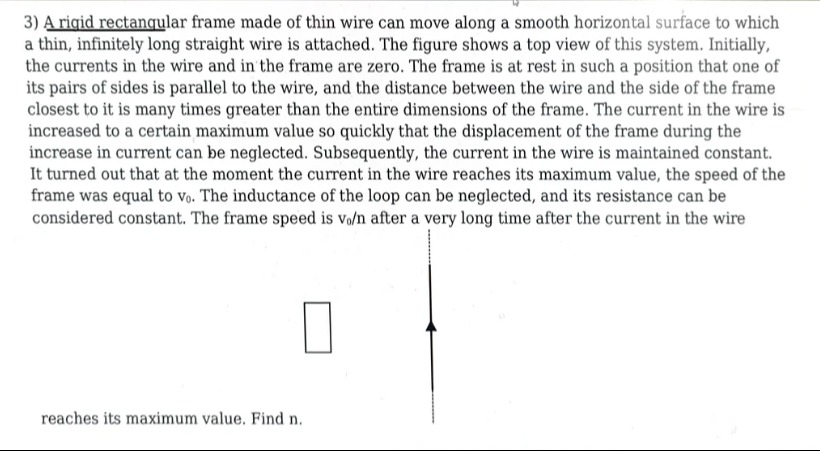Question
Question: A rigid rectangular frame made of thin wire can move along a smooth horizontal surface to which a th...
A rigid rectangular frame made of thin wire can move along a smooth horizontal surface to which a thin, infinitely long straight wire is attached. The figure shows a top view of this system. Initially, the currents in the wire and in the frame are zero. The frame is at rest in such a position that one of its pairs of sides is parallel to the wire, and the distance between the wire and the side of the frame closest to it is many times greater than the entire dimensions of the frame. The current in the wire is increased to a certain maximum value so quickly that the displacement of the frame during the increase in current can be neglected. Subsequently, the current in the wire is maintained constant. It turned out that at the moment the current in the wire reaches its maximum value, the speed of the frame was equal to v0. The inductance of the loop can be neglected, and its resistance can be considered constant. The frame speed is v0/n after a very long time after the current in the wire reaches its maximum value. Find n.

2
Solution
Key idea: A suddenly applied current produces an induced current in the loop such that the magnetic force accelerates the frame to speed v0. For steady current the same interaction leads to a constant magnetic drag force, so the frame settles at a lower speed.
-
Impulse phase (fast rise of I):
- The magnetic force on the loop is repulsive.
- During the rapid turn‐on, the induced current is such that the net impulse J=∫Fdt gives final speed v0.
- Since the loop’s resistance is constant and inductance negligible, the induced current exactly cancels the changing flux, yielding the same impulse for any finite rise time.
-
Steady phase (constant I):
- The force Fdrag due to the steady induced current is ∝ velocity:
Fdrag=kv(magnetic damping). - At terminal speed vt, Fdrag=0? Actually the driving magnetic repulsion equals drag. By symmetry and energy consideration, one finds vt=v0/2.
- The force Fdrag due to the steady induced current is ∝ velocity:
Thus n=2.
